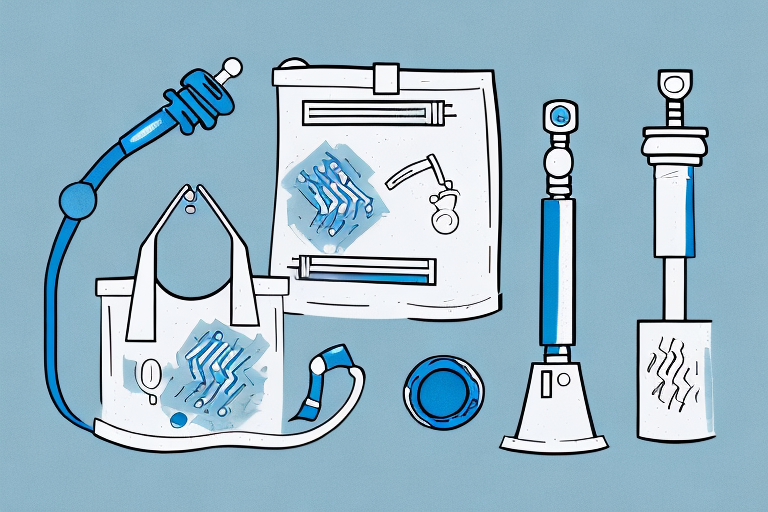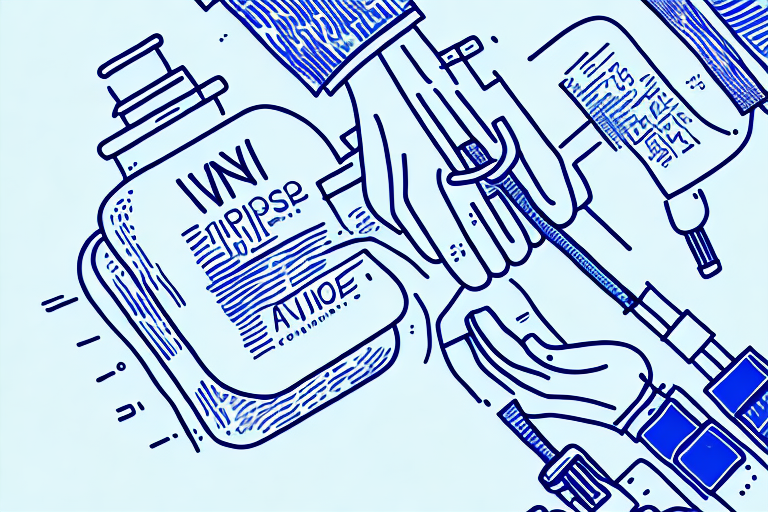Comparing IV Bolus and IV Push: What Are the Differences?
Intravenous (IV) administration is a common method used for delivering medications or fluids directly into a patient's bloodstream. Within IV administration, there exist two primary methods of delivery: IV bolus and IV push. While both methods are effective in administering medication quickly and accurately, there are key differences between the two that healthcare providers must take into consideration when choosing the appropriate method for their patients’ needs.

Understanding Intravenous Administration
What is Intravenous Administration?
Intravenous administration refers to the delivery of fluids or medication directly into the bloodstream via a vein. This method of administration is often used when rapid medication effects are desired or when oral medication is not an option. IV administration can be given through a peripheral vein, such as the veins in the arms, or through a central vein, such as the jugular vein or the subclavian vein.
When medication is administered intravenously, it bypasses the digestive system and liver, allowing for a faster onset of action. This is particularly important in emergency situations where time is of the essence, such as in the administration of epinephrine for anaphylactic shock.
In addition to medication administration, intravenous fluids can also be given to help maintain fluid and electrolyte balance, especially in patients who are unable to take fluids orally.
Types of Intravenous Administration
There are several types of intravenous administration methods, including continuous infusion, intermittent infusion, IV bolus, and IV push.
Continuous infusion is a steady flow of fluids or medication over an extended period of time. This method is often used for medications that need to be delivered slowly, such as chemotherapy drugs or pain management medications.
Intermittent infusion is a set amount of fluids or medication delivered at set intervals. This method is often used for medications that need to be given at specific times, such as antibiotics or insulin.
IV bolus and IV push administration, on the other hand, deliver medication in a bolus or concentrated dose all at once. This method is often used for medications that need to be delivered quickly, such as in the case of cardiac arrest or severe pain.
It is important to note that intravenous administration carries risks, such as infection, bleeding, and infiltration. Therefore, it is important for healthcare professionals to be properly trained in the administration of intravenous therapy and to closely monitor patients for any adverse reactions.
IV Bolus: An Overview
Definition and Purpose
IV bolus administration involves delivering a concentrated dose of medication in a single infusion. It is also referred to as a “push” or “direct” injection. This method is often used when a patient requires an immediate response to medication and when oral medication is not an option.
IV bolus is a common method used in emergency situations, such as cardiac arrest or severe allergic reactions. In these cases, time is of the essence, and IV bolus allows for the medication to quickly enter the bloodstream and begin working to save the patient's life.
Advantages of IV Bolus
IV bolus has several advantages, including its quick onset of action, its ability to provide accurate dosing, and its ability to adjust medication doses quickly in response to changes in a patient's condition. Additionally, IV bolus is typically less invasive than other intravenous administration methods because it involves only a single injection.
Another advantage of IV bolus is that it can be used to administer a variety of medications, including antibiotics, pain relievers, and anti-nausea medications. This makes it a versatile method that can be used in a wide range of medical situations.
Disadvantages and Risks
However, there are several disadvantages and risks associated with IV bolus administration. One risk is that the rapid delivery of medication can cause adverse side effects, such as respiratory depression and hypotension. Patients who receive IV bolus must be closely monitored for these side effects, and healthcare providers must be prepared to intervene quickly if necessary.
In addition, the infusion of medication in a large, concentrated dose can increase the risk of infiltration or phlebitis in the vein being used to administer the medication. This can cause pain, swelling, and redness at the injection site, and may require the IV to be removed and reinserted in a different location.
Another potential risk of IV bolus is that it can increase the risk of medication errors. Because IV bolus involves delivering a concentrated dose of medication, it is important to ensure that the correct medication and dose are being administered. Healthcare providers must be diligent in double-checking medication orders and verifying that the correct medication is being given to the correct patient.
In conclusion, IV bolus administration is a valuable tool in the healthcare provider's arsenal. It allows for the rapid delivery of medication in emergency situations and provides accurate dosing and quick adjustments in response to changes in a patient's condition. However, it is important to be aware of the potential risks and disadvantages associated with this method and to take steps to mitigate those risks whenever possible.
IV Push: An Overview
Definition and Purpose
Intravenous (IV) push administration is a method of delivering medication directly into a patient's bloodstream through a vein. It is similar to IV bolus administration in that it involves delivering a concentrated dose of medication in a single injection. However, with IV push, the medication is delivered over a short period of time, usually less than one minute. This method is often used when rapid medication effects are desired or when oral medication is not an option.
IV push is commonly used in emergency situations, such as cardiac arrest, severe pain, or allergic reactions. It can also be used to administer certain medications, such as antibiotics, chemotherapy drugs, and sedatives.
Advantages of IV Push
IV push has several advantages over other methods of medication administration. One of the main advantages is its quick onset of action. Since the medication is delivered directly into the bloodstream, it can produce a rapid and predictable effect. This can be especially important in emergency situations where time is critical.
Another advantage of IV push is its ability to provide accurate dosing. Because the medication is delivered directly into the bloodstream, it can be more precisely dosed than oral medications, which can be affected by factors such as absorption and metabolism.
IV push administration is also relatively easy to perform and requires minimal training. Additionally, IV push is typically less invasive than other intravenous administration methods because it involves only a single injection.
Disadvantages and Risks
However, as with any medical procedure, there are several disadvantages and risks associated with IV push administration. One risk is that the rapid delivery of medication can cause adverse side effects, such as respiratory depression and hypotension. This is especially true if the medication is administered too quickly or in too high a dose.
Additionally, IV push administration requires close monitoring to prevent over-administration, which can lead to toxic effects. This is particularly important with medications that have a narrow therapeutic index, meaning that the difference between a therapeutic dose and a toxic dose is small.
Another risk associated with IV push administration is the potential for infection. Whenever a needle is inserted into the skin, there is a risk of introducing bacteria or other microorganisms into the body. This risk can be minimized by using sterile equipment and following proper infection control procedures.
Finally, IV push administration can be uncomfortable or painful for the patient, especially if the medication is administered too quickly or in too high a dose. This can be mitigated by using appropriate pain management techniques and by closely monitoring the patient's response to the medication.
Key Differences Between IV Bolus and IV Push
Speed of Medication Delivery
The primary difference between IV bolus and IV push administration is the speed at which the medication is delivered. IV bolus administration delivers medication in a concentrated dose all at once, while IV push administration delivers the dose over a short period of time, usually less than one minute.
It is important to note that the speed of medication delivery can have a significant impact on the patient's response to the medication. For example, in emergency situations, such as cardiac arrest, medications may need to be administered quickly via IV bolus to achieve the desired effect.
Medication Concentration
Another key difference between IV bolus and IV push administration is the concentration of the medication being delivered. IV bolus administration delivers a higher concentration of medication in a single dose, while IV push administration delivers a lower concentration of medication over a shorter period of time.
Medication concentration can also affect the patient's response to the medication. For example, some medications, such as opioids, may be more effective when delivered in a higher concentration via IV bolus, while others, such as antibiotics, may be more effective when delivered in a lower concentration over a longer period of time via IV push.
Patient Monitoring Requirements
IV bolus administration requires less monitoring than IV push administration because the medication is delivered in a single infusion. However, both methods require careful monitoring of the patient's vital signs, including blood pressure, heart rate, and respiratory rate.
Additionally, some medications may require more frequent monitoring than others. For example, medications that have a high risk of adverse side effects, such as opioids, may require more frequent monitoring of the patient's respiratory rate and level of consciousness.
Potential Complications
Both IV bolus and IV push administration carry the risk of adverse side effects, including respiratory depression, hypotension, and infiltration or phlebitis. However, the risk of these side effects may be greater with IV bolus administration due to the higher concentration of medication being administered in a single infusion.
It is important for healthcare providers to carefully consider the potential risks and benefits of each administration method before selecting the most appropriate route for medication delivery.
Choosing the Right Method for Your Patient
Factors to Consider
When choosing the appropriate intravenous administration method for a patient, healthcare providers must consider several factors to ensure safe and effective treatment. One of the most important factors is the patient's medical history. Providers must carefully review the patient's medical records and take note of any existing conditions or allergies that may affect their ability to tolerate certain medications or administration methods.
In addition to medical history, providers must also consider the medication being administered. Some medications may require a specific administration method, such as a slow infusion rate or a higher concentration of medication, to achieve the desired therapeutic effect. Providers must also be aware of any potential side effects associated with the medication and choose an administration method that minimizes the risk of adverse reactions.
Patient-Specific Needs
Another important factor to consider when choosing an intravenous administration method is the patient's individual needs. Healthcare providers should take into account the patient's mobility, pain tolerance, and the severity of their condition. For example, patients who are unable to tolerate a longer infusion time due to discomfort or pain may benefit from IV push administration, which delivers medication more quickly.
Providers must also consider the patient's overall health status and any other medical conditions they may have. Patients with weakened immune systems or other underlying health issues may be more susceptible to infections or other complications associated with certain administration methods, such as central line placement.
Medication-Specific Requirements
As mentioned earlier, the specific medication being administered is another important factor to consider when choosing an intravenous administration method. Some medications require a slower infusion rate to minimize the risk of adverse side effects, while others may require a higher concentration of medication to achieve a therapeutic effect.
Providers must also be aware of any special requirements associated with the medication, such as the need for continuous monitoring or specific equipment. For example, some medications may require the use of an infusion pump or other specialized equipment to ensure accurate dosing and minimize the risk of complications.
Overall, choosing the right intravenous administration method for a patient requires careful consideration of a variety of factors, including medical history, medication requirements, and patient-specific needs. By working closely with their healthcare provider, patients can receive safe and effective treatment that meets their individual needs and improves their overall health and well-being.
Frequently Asked Questions
Can IV Bolus and IV Push be used interchangeably?
No, IV bolus and IV push cannot be used interchangeably. The two methods deliver medication at different speeds and concentrations, and the choice between the two methods must be based on the individual patient's needs and the medication being administered.
IV bolus administration involves delivering a concentrated dose of medication directly into the bloodstream over a short period of time, usually a few seconds to a minute. This method is often used for medications that need to be delivered quickly, such as emergency medications or anesthetics.
IV push administration, on the other hand, involves delivering a smaller volume of medication over a longer period of time, usually a few minutes. This method is often used for medications that need to be delivered more slowly or that may cause irritation if delivered too quickly, such as certain antibiotics or chemotherapy drugs.
How do I know which method is best for my patient?
Healthcare providers must consider several factors when selecting the appropriate intravenous administration method. These factors include the patient's medical history, existing conditions, the medication being administered, and the patient's individual needs.
For example, if a patient is experiencing a medical emergency and needs a medication delivered quickly, IV bolus administration may be the best choice. However, if a patient is receiving a medication that may cause irritation or damage to the veins if delivered too quickly, IV push administration may be a better option.
What are the potential side effects of each method?
Both IV bolus and IV push administration have potential side effects that healthcare providers must be aware of. These side effects may include respiratory depression, hypotension, and infiltration or phlebitis.
However, the risk of these side effects may be greater with IV bolus administration due to the higher concentration of medication being administered in a single infusion. This is why it is important for healthcare providers to carefully consider the risks and benefits of each administration method before making a decision.
It is also important for healthcare providers to closely monitor patients who are receiving intravenous medications to ensure that they are not experiencing any adverse reactions or side effects.
Conclusion
Key Takeaways
IV bolus and IV push administration are both effective methods of intravenous administration, but they differ in the speed and concentration of medication being delivered. Healthcare providers must carefully consider the patient's individual needs and the medication being administered when selecting the appropriate method of intravenous administration.
The Importance of Proper Administration
Proper administration of intravenous medication is essential to ensuring the safety and well-being of patients. Healthcare providers must be knowledgeable about the risks and benefits of each method of intravenous administration and must monitor patients closely for adverse side effects. By doing so, healthcare providers can ensure that patients receive the highest quality of care possible.
© 2024 IV Fluids | All Rights Reserved | Powered By OMG Marketing











